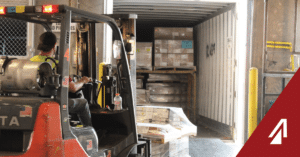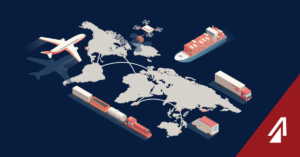Logistics companies implement various strategies and technologies to engineer solutions that optimize the supply chain and reduce transportation spend. Effectively implementing these strategies can improve service levels and customer satisfaction while improving operational efficiency.
Here are the top 10 cost-saving strategies:
- Shipment Consolidation: Consolidating shipments can streamline logistics operations, making planning and executing deliveries easier, reducing delays, and improving overall service levels. By combining smaller shipments from multiple clients or suppliers into a larger shipment, companies can maximize load capacity, reduce handling fees, and lower freight costs per unit. Consolidation can also lead to better visibility and predictability in the supply chain, allowing for more accurate demand forecasting and inventory planning.
- Route Optimization: Route optimization allows companies to allocate resources more effectively, ensuring that the right transportation providers are assigned to the most efficient routes. Using advanced software, logistics companies can determine optimal delivery modes and routes, improving delivery times and reducing time, labor costs, and fuel consumption. Many route optimization systems can also adjust in real-time based on traffic conditions, weather, and other variables for dynamic planning.
- Data Analytics: By analyzing historical performance data, trends, and seasonality, companies can better identify inefficiencies or areas for improvement and better predict demand and load optimization. Accurate forecasting allows companies to make informed decisions that enhance profitability, optimize transportation routes and schedules, and minimize unnecessary transportation costs. Logistics companies also use analytics to simulate different supply chain scenarios, helping to understand the impact of changes in routes, carriers, or demand fluctuations on transportation costs.
- Fleet Management: Using GPS and other tracking tools allows companies to monitor vehicle performance, optimize maintenance schedules, and reduce idle times, ultimately leading to cost savings. Monitoring fuel consumption and driver performance also helps identify opportunities to promote eco-friendly driving practices and improve driver training.
- Cross-docking: This practice minimizes storage time by transferring products directly from inbound to outbound transportation, reducing warehousing costs. Streamlining the process of moving goods allows companies to maintain lower inventory levels and reduce the time goods spend in the supply chain. In addition, cross-docking leads to quicker deliveries and less time spent in handling phases or in storage.
- Automation and Technology: Investing in automation technologies, such as automated sorting systems and warehouse robotics, can streamline operations, reduce delays, lower labor costs, and improve accuracy. Automated tracking systems also provide real-time updates on shipment status, allowing companies to respond swiftly to issues, enable better planning and resource allocation, scale operations efficiently when needed, and reduce unnecessary expenses.
- Sustainable Practices: Implementing eco-friendly practices, such as using energy-efficient vehicles, exploring alternative fuel options, and reducing waste, can lower costs while working toward broader, long-term sustainability goals. Sustainable practices encourage maximizing utilization, reducing transportation needs, lowering fuel consumption and CO₂ emissions, and minimizing a company’s environmental impact. While initial costs may be associated with transitioning to sustainable practices, the long-term savings can be substantial.
- Inventory Management: By maintaining appropriate inventory levels and managing inventory strategically, businesses can avoid overstocking and understocking situations, reduce lead times, and lower the need for expedited shipments. Companies use data analytics to forecast demand accurately and anticipate inventory needs. Implementing just-in-time (JIT) inventory systems can also help reduce holding costs and minimize excess stock.
- Provider Analysis: By analyzing and vetting different transportation providers, companies can take advantage of the benefits of outsourcing to third-party providers who have specialized expertise and technology, identify cost-effective options based on rates, services, and reliability, and select providers that offer the best value for a company’s specific needs. Metrics also aid in evaluating carrier performance, including on-time delivery rates, cost per shipment, and service quality.
- Supplier Negotiations: Building strong relationships and good communication with suppliers can lead to better shipping rates and more favorable terms that help lower overall logistics costs. Negotiations can result in more flexible shipping terms for better cash flow and better service levels due to established relationships, and some suppliers may offer discounts for bulk orders or long-term contracts.
Effective implementation of cost-saving opportunities is an ongoing process of continuous improvement. In-depth analysis allows companies to make informed decisions that enhance their transportation strategies, leading to significant cost reductions while maintaining service quality. It also allows companies to pass these savings on to customers or reinvest in their business for additional improvements in the future.
At ProTrans, we offer comprehensive Solution Design and Procurement services in addition to our expertise in specialized logistics. Reach out to ProTrans today to discuss the best options for taking a holistic approach to your supply chain transportation needs and identifying strategies to reduce your overall transportation spend.



